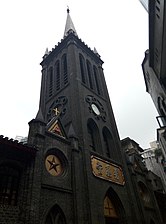Ba–Shu culture
Appearance

Ba–Shu culture (Chinese: 巴蜀文化; pinyin: Bāshǔ wénhuà; Wade–Giles: Pa-Shu wên-hua) refers to the culture of Sichuan province and Chongqing as well as parts of neighboring Yunnan and Guizhou, all of which are regions which speak Southwestern Mandarin. It has a long history of over 3000 years and is claimed to be one of the cradles of Chinese civilization.[1][2][3]
Ancient writing system
Traditional language
Architecture

Sichuanese architecture
Sichuanese garden
Visual arts


Performing arts
Clothing
Food culture
Others
- Religious sites in Sichuan
-
Golden Temple of Mount Emei of the Chinese Buddhist tradition.
-
Statues of buddhas at a Litang monastery of the Tibetan Buddhist tradition.
-
St. Joseph's Cathedral, Chongqing (Roman Catholic).
See also
External links
References
- ^ 巴蜀文化渊源. huaxia.com. June 2006. Archived from the original on May 2, 2019. Retrieved September 7, 2017.
- ^ 巴蜀文化. hk.chiculture.net.
- ^ 四川师范大学巴蜀文化中心. Center for Bashu Cultural Studies, Sichuan Normal University.






![Baba Mosque [zh], a Sichuanese Sufi mosque in Langzhong.](http://upload.wikimedia.org/wikipedia/commons/thumb/1/1f/%E5%B7%B4%E5%B7%B4%E5%AF%BA.JPG/338px-%E5%B7%B4%E5%B7%B4%E5%AF%BA.JPG)


